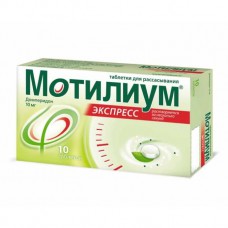Expiration date: 11/2026
Description:
Antiemetic drug of central action, blocking dopamine receptors.
Composition:
1 tablet contains 10 mg of domperidone.
Indications for use:
A complex of dyspeptic symptoms, often associated with delayed gastric emptying, gastro-esophageal reflux, esophagitis:
- feeling of fullness in the epigastrium, early satiety, feeling of bloating, pain in the upper abdomen,
- belching, flatulence,
- nausea, vomiting,
- heartburn, belching with or without stomach contents.
Nausea and vomiting of functional, organic, infectious origin, as well as caused by drug therapy or a violation of the diet.
A specific indication is nausea and vomiting caused by dopamine agonists when used in Parkinson's disease (such as levodopa and bromocriptine).
Contraindications:
- Established intolerance to the drug and its components,
- prolactin-secreting pituitary tumor (prolactinoma),
- concomitant use of oral ketoconazole, erythromycin or other potent inhibitors of CYP3A4, causing lengthening of the QT interval, such as fluconazole, voriconazole, clarithromycin, amiodarone and telithromycin (see "Interaction"),
- gastrointestinal bleeding, mechanical obstruction or perforation (i.e., when stimulation of the motor function of the stomach can be dangerous),
- children up to age 5 years (for this dosage form),
- the liver of moderate and severe,
- phenylketonuria.
Pharmacodynamics:
Domperidone is a dopamine antagonist with antiemetic properties. However, domperidone does not penetrate the blood-brain barrier well. The use of domperidone is rarely accompanied by extrapyramidal side effects, especially in adults, but domperidone stimulates the release of prolactin from the pituitary gland. Its antiemetic effect may be due to a combination of peripheral (gastrokinetic) action and antagonism to dopamine receptors in the chemoreceptor trigger zone. Animal studies and low concentrations of the drug found in the brain suggest a central effect of domperidone on dopamine receptors.
When used orally, domperidone increases the duration of antral and duodenal contractions, accelerates gastric emptying and increases the pressure of the sphincter of the lower esophagus in healthy people. Domperidone has no effect on gastric secretion.
Pharmacokinetics:
Domperidone is rapidly absorbed after ingestion on an empty stomach
Domperidone should be taken 15-30 minutes before meals. A decrease in the acidity in the stomach leads to a violation of the absorption of domperidone. Oral bioavailability is reduced with pre-administration of cimetidine and sodium bicarbonate. When taking the drug after a meal, it takes longer to achieve maximum absorption.
Domperidone undergoes rapid and intensive metabolism.
Excretion in the urine and feces is 31 % and 66 % of the dose when taken orally, respectively. The proportion of the drug released unchanged is small (10% - with feces and approximately 1 % - with urine). The plasma half-life after a single oral dose is 7-9 hours in healthy volunteers, but increases in patients with severe renal insufficiency.
Side effects:
Adverse reactions observed in patients taking Motilium ® : depression, anxiety, decreased or no libido, headache, drowsiness, akathisia, dry mouth, diarrhea, rash, itching, galactorrhea, gynecomastia, pain and sensitivity in the mammary glands, menstrual disorders and amenorrhea, lactation disorders, asthenia, hypersensitivity, urticaria, swelling and discharge from the mammary glands.
Disorders of the immune system. Very rare: anaphylactic reactions, including anaphylactic shock.
Mental disorders. Very rare: agitation, nervousness (mainly in newborns and children).
Disorders of the nervous system. Very rare: extrapyramidal disorders, seizures (mainly in newborns and children).
Disorders of the cardiovascular system. Very rare: prolongation of the QT interval, ventricular arrhythmia*, sudden coronary death*.
Disorders of the skin and subcutaneous tissues. Very rare: Quincke's edema, urticaria.
Disorders of the kidneys and urinary tract. Very rare: urinary retention.
Laboratory and instrumental data. Very rare: deviations of laboratory parameters of liver function, increased blood prolactin levels.
Method of preparation or application:
Inside. It is recommended to take Motilium ® tablets before meals, if they are taken after meals, the absorption of domperidone may slow down. The duration of continuous use of the drug without a doctor's recommendation should not exceed 28 days.
Adults and children over 12 years of age and weighing 35 kg or more:
1-2 tablets of 10 mg 3-4 times a day. The maximum daily dose is 8 tablets (80 mg).
Children aged 5 to 12 years and weighing 35 kg or more:
1 tablet of 10 mg 3-4 times a day. The maximum daily dose of domperidone is no more than 8 tablets (80 mg).
Use in children Motilium ® resorption tablets are indicated only for children with a body weight of 35 kg or more, in children's practice, Motilium ® suspension should mainly be used. Use in patients with impaired renal function, the frequency of taking Motilium ® should be reduced to 1-2 times a day, depending on the severity of the disorders, a dose reduction may also be required.
Since the resorption tablets are quite fragile, they should not be pushed through the foil to avoid damage. In order to get the tablet from the blister, you need the following:
- take the foil by the edge and completely remove it from the cell in which the tablet is located,
- gently push down from the bottom,
- remove the tablet from the packaging.
Place the tablet on your tongue. Within a few seconds, it will disintegrate on the surface of the tongue, it can be swallowed with saliva, without drinking water.



